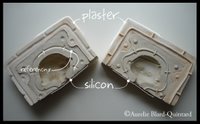MOULDS
Just as every puppet is conceived for a certain type of action, a mould is very much made regarding what you're going to use it for: are you going to cast silicon, or press-mold some clay in it...?
As a rule: if you want the cast to be soft, use a hard mould (= plaster…), and if the cast is hard, use a soft mould.
This being said, the main thing with mould is patience: you might have to redo them quite a few time before you reach perfection (or at least something decent)
Once you have your platicine sculpture ready, dip the part you don’t want to cast right now (we’re doing a several part mould here) in clay (=loam: the one used to make pots)

Because the clay is water based, it won’t mix with you oil based plasticine: it will be easy to clean it with water when you want to cast the second part of the mould.
Be careful to be gentle when you press the clay next to the plasticine.
Remember to put some lumps of clay, or to dig small holes to reference the parts.
TIP: it is time consuming, but you will have a much better mould if you take time to build a “clay bath” that is as perpendicular to the plasticine sculpture as possible.
You can use a disposable cup, an ice cream container… use your imagination.
The only requirement is that the box is higher than the item you’re casting.
Then pour either silicon or plaster, depending on what kind of cast you want, on the still exposed area.
If you’re using silicon, maybe you want to apply a very thin coat first (to avoid bubbles) and when this first coat is dry, pour more silicon. And maybe some plaster after that, to reinforce the mold (ideal if you want to press-mould some clay in your mould)

(you can use water to remove the last bit of clay that would remain on your sculpture. Use cold water only, so the plasticine doesn’t get soft)

If your using plaster, apply washing up liquid (and allow it to dry)on every part before you cast an adjacent one: it will ease the separation between the two plaster parts.
With Silicon, use Vaseline as an insulator between two parts


For certain kind of mould, you will need to make a little drainpipe by surrounding the plasticine to be cast by a tube of plasticine (at 1 cm of the main cast border). It will allow the excess of silicon or any other material to go away from the immediate surrounding of your cast: this way, the surrounding of the actual cast will be as clean as possible (sometimes some material still remain, and you have to carefully trim it)
In the area of moulding and casting, I have a reference book:
LE GUIDE DU MOULAGE, by Jean-Pierre Delpech and Marc-Andre FigueresEdition Eyrolles ISBN 2-212-02680-3
Unfortunately, it is written in French only.






No comments:
Post a Comment